Let me paint a picture for you: there’s this fabulous ball of fire in the sky (yep, the sun), and inventors thought, “Hey, why not catch those rays and turn them into a power cocktail for our homes?” Lo and behold, solar panels stepped into the limelight as the poster child for clean energy solutions. Now, as your neighborhood energy enthusiast, I’m here to unravel a persistent riddle—do solar panels generate AC or DC?
We’ve got these neat cosmic catchers (solar panels, for the uninitiated) soaking up sunbeams and producing electricity. What’s less known is they’re throwing out DC power—like a stable, low-drama relationship. But here’s the plot twist: our home appliances and the bustling electrical grid prefer the more versatile AC power. I know, drama, right?
To turn this solar panel electricity into an alternative energy source compatible with our love for powered gadgets, a behind-the-scenes hero called an ‘inverter’ steps up. This gizmo flips DC into AC faster than a pancake on Sunday morning. So, let’s plug into the world of solar power generation and get the current on how solar energy keeps our modern lives buzzing.
Key Takeaways
- Solar panels generate DC, but homes and the grid party on AC.
- Inverters are the ultimate mixologists, converting solar panel DC into AC.
- A solar panel system becomes a clean energy superhero with an inverter sidekick.
- The solar panel electricity serves up an alternative energy source for our AC-loving abodes.
- Embracing solar power generation means signing up for an eco-conscious lifestyle.
- Understanding the AC/DC tango underscores solar’s role as a savvy clean energy solution.
Understanding the Basics of Solar Panel Electricity
As someone deeply immersed in the world of renewable energy, I find the inner workings of solar panels to be nothing short of magic—well, scientifically explainable magic. Let’s get into the nitty-gritty of how these sleek panels convert sunlight into the electricity that powers everything from your espresso machine to your electric car.
How Photovoltaic Technology Captures Sunlight
Imagine an invisible dance of particles happening right on your rooftop. Solar panels harness the power of the sun using the photovoltaic effect. This process is all thanks to materials like silicon, which acts like a party venue for photons and electrons. When sunlight hits, photons encourage electrons to move around, creating a flow of electric current. I consider this the first step in the remarkable journey of solar power generation.
Direct Current (DC) Produced by Solar Panels
What’s interesting is that this electricity is not immediately ready to power our AC-loving appliances. Solar panels produce what’s known as direct current (DC). It’s the raw, straight-out-of-the-solar-oven form of electricity where electrons flow in one unidirectional route. This direct current is essential for the solar panel conversion process, ultimately serving as the blueprint for useful power.
The Role of Inverters in Solar Systems
If solar panels are the creators of electricity, think of inverters as the translators. Their role is crucial—they convert the DC from the solar panels into alternating current (AC), which is what our homes and the grid can actually use. An inverter’s like that friend who translates your sarcasm so it doesn’t get lost in translation. It ensures the seamless energy conversion process, feeding our homes and feeding back into the power grid without a hitch.
Now, let’s break down the components of the solar panel system:
| Component | Function | Significance |
|---|---|---|
| Photovoltaic Cells | Capture photons and convert them into DC | The primary producer of solar energy |
| Solar Inverter | Converts DC into AC | The bridge between solar production and practical home use |
| Electric Grid | Distributes electricity | The recipient of excess solar power, enabling energy sharing |
In the quest for embracing solar power, understanding the inverter’s role is akin to grasping why your car needs a transmission—it’s about translating power into a usable form. And that’s how the sunlight that tickles our rooftop transforms into the energy that powers our homes. Isn’t that just electrifying?
The Historical AC vs DC “War of the Currents”
Picture this: the late 1880s, a battle of intellect, ambition, and currents. It’s a narrative I find electrifying, the War of the Currents. We’re not talking about a skirmish over stream flows, but the tussle between ac vs dc electricity. On one side, you had Thomas Edison, that icon of invention, ardently pushing for direct current (DC). On the other, the enigmatic Nikola Tesla, whose brilliance illuminated the benefits of alternating current (AC).
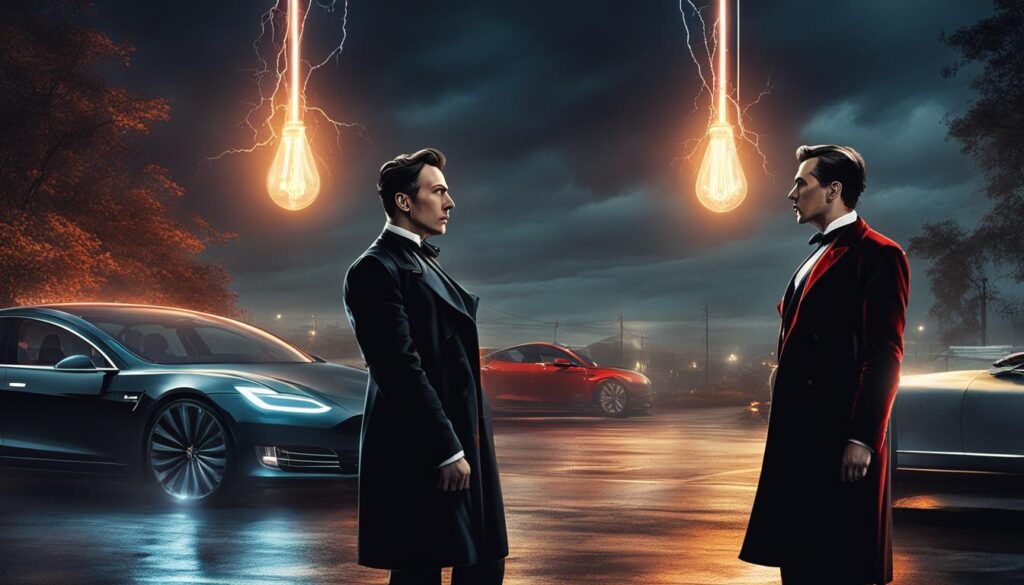
Why were they at loggerheads, you ask? Well, it boiled down to efficiency and practicality. Edison, already invested in DC technology, fervently argued for its adoption. However, DC had its shortcomings – like a marathon runner struggling to reach the finish line, it couldn’t cover long distances without power losses larger than a black hole.
Edison’s DC system was like trying to stream a blockbuster film through dial-up internet.
Tesla, meanwhile, saw AC as the future. The man was onto something because AC could change voltages with ease using transformers, akin to a chameleon shifting colors to suit its environment. This meant electricity could travel over vast distances, like a fearless explorer, without whimpering at the sight of a long journey.
Now, let’s get down to the nitty-gritty details of their face-off:
| Proponent | Current Type | Pros | Cons |
|---|---|---|---|
| Thomas Edison | DC | Simpler, more established technology | Poor long-distance efficiency |
| Nikola Tesla | AC | Greater transmission efficiency | Initial unfamiliarity with tech |
Ultimately, Tesla’s AC was the victor, slaying the DC dragon with efficiency and versatility. It’s why, to this day, AC is the mainstay of our electric grid. It powers everything from your grandma’s antique lamp to the latest smartphone that’s smarter than I’ll ever be. And while Edison didn’t win the war, his tenacity and contributions to the electric realm still resonate like a catchy tune from a vintage phonograph.
Let’s take a moment to tip our hats to these pioneers who laid the groundwork for the electric wonderland we live in. Whether we’re Team Edison or Team Tesla, we can all agree that the War of the Currents was more than a squabble over whose tech was tops. It sparked an evolution in how we harness energy, and we’re still feeling its thrilling current.
Solar Panel Systems: Operating on AC or DC?
Let’s get electrifyingly clear: I live in a world where my morning coffee brews thanks to solar panel electricity, thanks to that shiny array on my roof. But there’s a catch – my coffee machine doesn’t run on the same kind of juice that my panels cook up. Here’s the buzz: solar panels whip up juice in DC (Direct Current) form, but my beloved appliances crave AC (Alternating Current). Now, why is this mash-up of acronyms so pivotal for someone like me—and possibly you?
Why Solar Panel Output Matters for Home Use
Talk about a modern-day love story: renewable energy technology romances our homesteads, but for a happily ever after, we need a translator—a magical box called an inverter. This translator ensures the solar panel system speaks seamlessly with our home appliances, and honestly, without it, we’d be powerless, quite literally.
Comparing Appliance and Solar Panel Electrical Needs
Sit tight while I paint the picture: our homes are like a grand stage where AC electricity plays the lead role. Your fridge, air conditioner, and even electric guitar, all dance to the rhythm of AC electricity. Conversely, solar panel systems are backstage generating DC electricity. This natural mismatch is where the innovative spirit of the renewable energy sector shines through. The solution? Having an inverter in our solar panel system that flips DC into AC. Without this flip, my morning coffee would be a far-off dream, and we can’t have that, right?
Now, why don’t we take a look at the electrical needs of some common household items compared to what solar panel systems generate?
| Appliance | Type of Electricity Used | Solar Panel Output |
|---|---|---|
| Refrigerator | AC | DC |
| Air Conditioner | AC | |
| Laptop (with adapter) | AC | |
| LED Lights | AC |
So, there you have it! We’ve got solar panels on the DC side of the camp and pretty much everything else in the house rooting for Team AC. Could it be more star-crossed? But fear not, for this is one tale where technology acts as Cupid, ensuring that the love between solar panel electricity and home appliances continues unabated.
AC vs DC Electricity – A Layman’s Comparison
Ever found yourself caught in a lively dinner conversation where terms like AC and DC get tossed around like salad, but you’re not quite sure what’s in the mix? Worry not, because I’m here to demystify these electrifying concepts with a layman’s flair. You see, AC vs DC electricity isn’t just some arcane squabble from the history books; it’s a tale of how our modern-day marvel, solar panel electricity, came into being and continues to be a revolutionary alternative energy source.
Distinguishing AC from DC: Visual Examples
Picture this: If DC were a marathon runner, it’d be cruising along a straight, unwavering path, whereas AC is more like a salsa dancer, moving to the rhythm in a waveform that spells “let’s reverse and do it again!” That’s right, DC is the constant, one-directional flow of electric charge, a real straight-shooter. AC, on the other hand, alternates direction, much like the waves of the sea, cresting and dipping with dependable inconsistency. And here’s where your gadgets come into play: some are staunch fans of DC, while others can cha-cha only to AC’s tune.
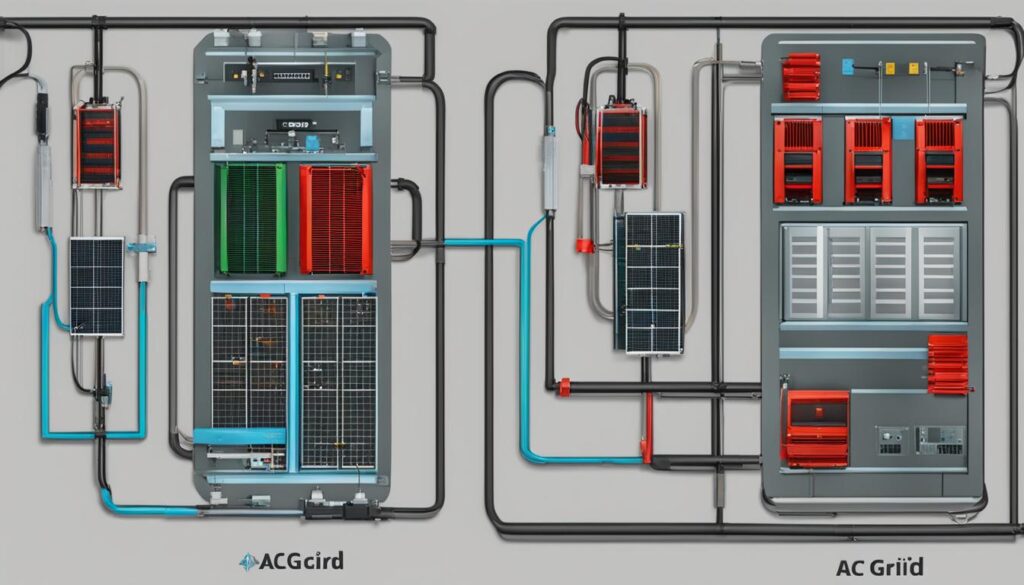
From Edison and Tesla to Modern Day Solar
Now let’s hop into our time machine and head back to the War of the Currents. It was like the ultimate showdown between two heavyweight inventors, Edison and Tesla, vying for electrical supremacy. Their rumble laid the groundwork for what powers our lives today. Fast forward, solar panels absorb the sun’s rays and churn out DC electricity in homage to Edison’s legacy. Yet, we live in an AC world—Tesla’s victory lap. So, our modern-day challenge is the energy conversion process, flipping DC into AC so our fancy tech gizmos can sip that sweet, sweet solar juice.
The beauty of it all? We’ve got these brilliant minds of yesteryears to thank for giving us a clean, renewable energy lifeline that powers everything from our iPhones to the fridge that keeps your leftover pizza chilled. It’s a beautiful ballet of energy dynamics, with the sun pirouetting around solar panels, nudging out electrons that march to the beat of DC, only to tango back into AC before lighting up your life. Truly, the past and present do a little dance, creating the power harmony we all rely on.
Do Solar Panels Generate AC or DC?
Often, when folks buzz about solar panels, they’re hit with the jargon-heavy question, “Do solar panels generate AC or DC?” See, as a liaison between the sun and our tech-filled lives, solar panels play a brilliant game of galactic catch. They snag those zesty sunbeams and whip up a batch of DC (Direct Current) power quicker than you can say “photosynthesis alternative.” This is where the real show starts—the solar power generation moment that bridges us to a clean energy solution.
But here’s the kicker: while these sun-wrangling wizards are busy churning out DC, our homes and gadgets are dancing to the tune of AC (Alternating Current). Hence, the inverter’s star role—it flips DC into AC faster than a pancake on Sunday morning, making the power play compatible with just about everything in our AC-loyal homes.
| Feature | Direct Current (DC) | Alternating Current (AC) |
|---|---|---|
| Current Flow | Unidirectional | Direction varies periodically |
| Source | Solar panels | Inverted from DC |
| Used by | Batteries, some electronics | Most household appliances, power tools |
| Inversion Necessity | Mandatory for home/grid use | Ready to use |
| Role in Clean Energy | Initial conversion step | Delivery to end users |
Squint at the table above, and you’ll notice that while both currents have their charm, it’s the inverter ballet that lets us savor the solar goodness in our daily grind. It’s quite the modern marvel that catapults that clean and nifty energy from our rooftops right into our Netflix binge sessions and midnight snack-making escapades. So, when that trivia night rolls around and someone drops the “do solar panels generate AC or DC?” query, you can bet your bottom dollar I’ll be winking and nodding with the vigor of one who knows the score in the clean energy game.
Transition from Panels to Power: The Inverter’s Role
Let’s dive into the heart of a solar panel system where the magic really happens—the inverter. Now, hold on to your hats because we’re about to explore how these smart devices take the DC power, which is what solar panels love to churn out, and convert it into AC power, which is what our homes and electric grids are thirsty for.
But not all inverters are created equal, oh no. We have a veritable buffet of options, each with their tasty advantages. For those who prefer each solar panel to dance to the beat of their own drum, microinverters are the go-to. With these bad boys, each panel is an independent artist, converting DC to AC right on the rooftop, which makes for some splendid performance monitoring—I can almost hear the humming of efficiency.
Types of Inverters in Solar Panel Systems
On the other side of the solar disco, we have the string inverters, reigning in the chaos by taking multiple solar panels and making them tango together. It’s less about the solo and more about the group choreography. String inverters might not let each panel shine on its own, but they do simplify our solar array and can cut down on installation waltz and maintenance mambo.
Understanding Microinverters vs String Inverters
I know what you’re thinking—how do I choose between these dazzling inverter stars? Well, it’s all about understanding your own solar dance floor. Do you have a small, uncomplicated roof with little shade? Maybe a string inverter will do the cha-cha. But if you’ve got a complex roof, with panels facing every which way and shade creeping in here and there, you might want to tap dance with microinverters instead. They’ll make sure each panel can shimmy in the sun, no matter where it lies.
- Microinverters: Solo artists, maximize performance under diverse conditions.
- String inverters: Group performers, best for large, uncomplicated arrays.
In conclusion, my savvy solar aficionados, the inverter’s role in the realm of renewable energy technology is akin to a masterful conductor orchestrating the beautiful symphony of a solar panel system’s performance. Whether it’s jiving with microinverters or swinging with string inverters, remember it’s about that seamless transition from sunbeams to screen-time, from daytime rays to nighttime blaze.
The Evolution and Potential of AC Solar Panels
Witnessing the evolution of renewable energy technology is like catching a glimpse of the future, materializing right before our eyes. And let me tell you, it’s electrifying! Leading the charge in this innovation parade are AC solar panels, the slick wizards that come with their magic wands, commonly known as microinverters. Now, allow me to gleefully pull back the curtain on how these sophisticated gizmos are revolutionizing the solar panel electricity game.
Integrating Microinverters: How AC Panels Differ
Ever heard of a party trick that actually saves money and hassle? Meet the integrated microinverters in AC solar panels. I like to think of microinverters as the multi-talented performers of the solar circus, dancing effortlessly on the high wire while balancing the solar panel system on their diminutive shoulders. They’re the reason AC panels can bid adieu to external inverters and say hello to a world of efficiency and reliability.
And here’s the kicker: the moment sunlight waltzes in, AC solar panels are already strutting their stuff, churning out alternating current like nobody’s business. That’s right, instant AC without the fuss—an impressive clean energy solution if ever there was one. To illustrate, let me serve up a table that makes things clearer than solar panel glass on a sunny day:
| Feature | AC Solar Panels | Traditional DC Panels |
|---|---|---|
| Inverter Type | Integrated Microinverter | External Inverter |
| Installation Simplicity | Easier, Less Equipment | More Complex, More Equipment |
| Electricity Output | AC (Alternating Current) | DC (Direct Current) |
| Expansion Flexibility | More Flexible | Less Flexible |
| Initial Cost | Higher due to Microinverters | Lower without Microinverters |
| Long-Term Benefit | Reduced Maintenance, Fewer Efficiency Losses | Potential for Higher Maintenance, Efficiency Losses |
The Benefits of AC Solar Panel Installations
Now, I’d feel like an absolute tease if I didn’t gush about the benefits of these AC solar panel installments. Imagine being able to increase your solar estate piece by piece without breaking a sweat—that’s the modularity these AC charmers bring to the table. Whether you’re a clean energy tycoon or a humble green enthusiast, the ease of adding more panels is just as satisfying as hitting the snooze button on a Monday morning.
But that’s not all. Think of each microinverter as a personalized coach for each solar module, making sure it’s achieving its maximum potential, regardless of what its panel peers are doing. This means a shaded or dirty panel won’t drag the team down. If that’s not a heartwarming example of solar camaraderie, I don’t know what is.
Ladies and gents, AC solar panels are not just a clean energy solution, they are the embodiment of convenience and future-readiness in the world of solar panel systems. And to sweeten the pot, here’s a lovely image to feast your eyes on:
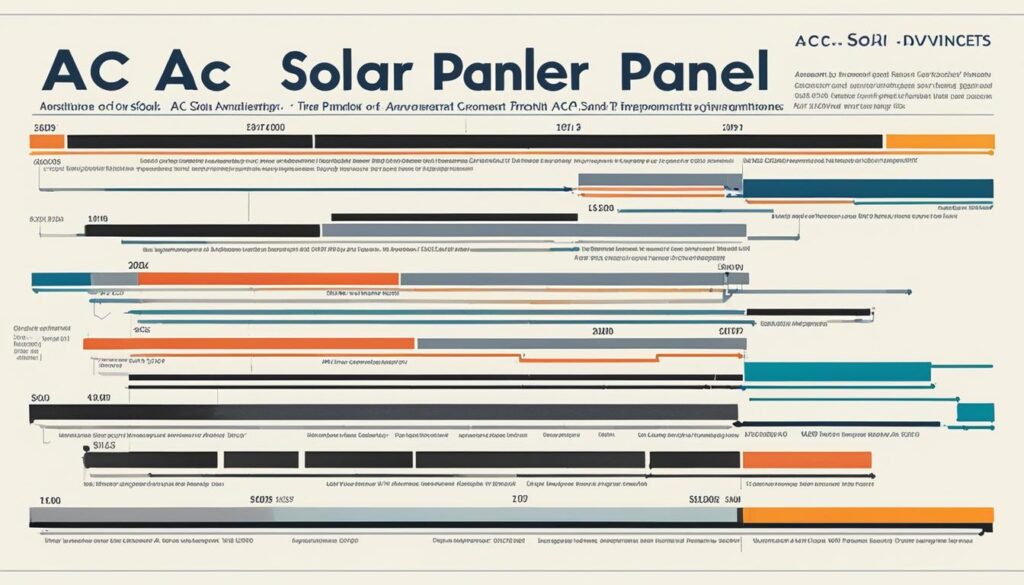
So, as we bid goodbye to today’s enlightening show, I take my hat off to these shining beacons of solar brilliance. AC solar panels, surely you deserve a standing ovation. Bravo!
Electrify Your Understanding: Solar and Battery Storage Explained
Let’s talk energy storage, a crucial sidekick in the solar power generation saga. Do solar panels generate AC or DC, you ask? They churn out DC like bees making honey, but then we enter the world of battery storage. Here’s where it gets juicier. Strap in as I shine a light on how this dynamic duo works hand-in-glove to keep your lights on past sunset.
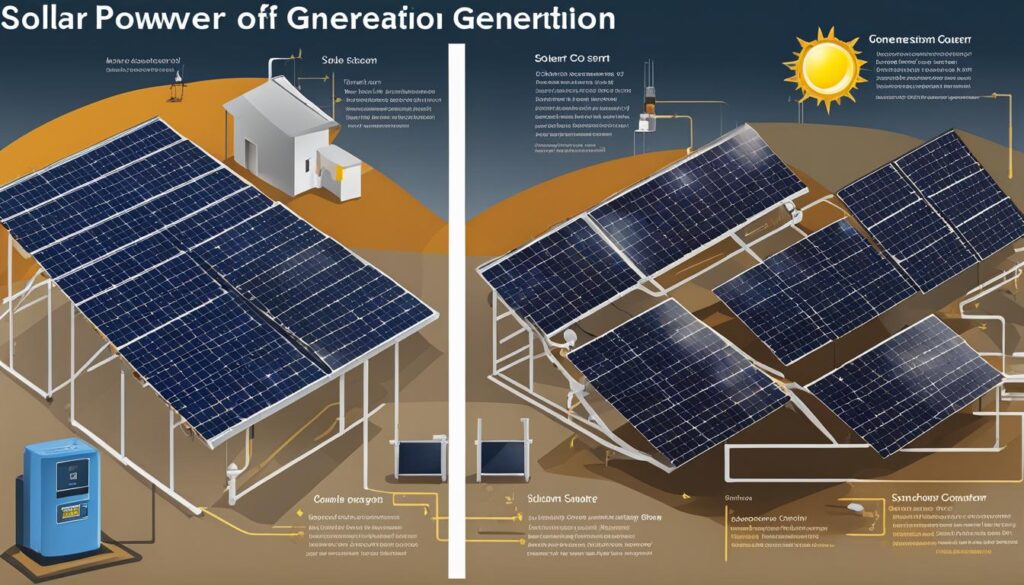
So, picture this: You’ve got all that sweet, sweet solar energy cascading down, and your panels lap it up but then what? You’re not going to use it all at once. No, my friend, you’ll need a slick system to bottle up that sunshine for a rainy day—or, you know, for nights. That’s where energy storage enters the chat.
Option A, we’ve got AC-coupled storage—you pop an inverter into the mix specifically for the battery. It’s sleek, it’s polished; it’s like getting a sidecar for your motorcycle after you’ve already been cruising for a while. Then, there’s Option B, DC-coupled storage. This little number hooks right up with your existing inverter, like a trailer hitched to your rig from the get-go. Less fuss and potentially kinder to your wallet, too.
| Storage Type | Connection | Pros | Cons |
|---|---|---|---|
| AC-Coupled | Separate inverter for battery | Great for retrofits, flexible | Additional equipment needed |
| DC-Coupled | Shares inverter with solar panels | More efficient, cost-effective for new installations | Less flexible if system expansion is needed later |
By marrying renewable energy technology with advanced storage solutions, we’re crafting an energy love story for the ages. Whether you’re retrofitting a vintage rig or rolling fresh off the lot, your solar setup, paired with the right battery, could dance circles around the old grid-dependant waltz. AC or DC, it’s all about storing that eco-friendly vroom to power your home—clean, green, and oh-so serene.
Conclusion
In our journey to demystify solar technology, we’ve traversed the valleys and peaks of volts and currents, untangling the complex strands of energy conversion. It’s no small feat to wrap our heads around the concept that solar panels generate AC or DC, but here we are, a touch wiser and a lot more informed. I’ve decoded the technical jargon so you don’t have to, squinting at the fine print to ensure you can have your solar cake and eat it too—with a side of sustainable sunshine.
Decoding the Technical Jargon of Solar Output
You’ve heard it, I’ve said it: solar panel electricity is not just a flash in the pan; it’s a clean energy solution that’s here to energize our lives sustainably. Knowing that the DC magic conjured by solar panels needs a quick change of costume to AC for the grand performance on the home stage—it’s integral, really. This isn’t just buzz-worthy solar power generation; it’s the kind of party trick that keeps the lights on and our Earth a tad cooler.
The Future of Residential Solar: A Current Perspective
Peering into the crystal ball of renewable energy technology, I see a future where solar panel systems are as ubiquitous as smartphones, and inverter innovation is the arena where tech gladiators battle for supremacy. AC solar panels are muscling their way onto the scene, promising a sleeker, streamlined solar experience. Solar, my friends, isn’t just an alternative anymore; it’s the mainstream melody to which we’ll all be tapping our renewable rhythm. As they say, the future’s so bright, you’ll need energy-efficient shades.
FAQ
Do solar panels generate AC or DC electricity?
Let me shine some light on this – solar panels inherently generate direct current (DC) electricity as they capture sunlight and convert it into energy.
What is photovoltaic technology and how does it capture sunlight?
Think of photovoltaic technology as nature’s own little miracle, using semiconductors to catch sunbeams and get electrons all excited, which means generating electricity for you and me.
What role do inverters play in solar systems?
The inverter is like the translator in the world of solar – it turns the DC electricity from your solar panels into AC power, speaking the language of your home appliances and the grid.
Can you briefly explain the “War of the Currents” between Edison and Tesla?
Ah, the legendary bout of electrical titans! Edison was team DC, and Tesla was all about that AC life. They duked it out in the late 19th century to decide how we’d get our buzz – AC won for the grid, but solar panels are bringing DC back in style.
Why does solar panel output matter for home use?
Simply put, our homes run on AC, but solar panels are all about that DC, so to keep our fridges humming and lights shining, we’ve got to switch that current up to AC.
How do appliance and solar panel electrical needs compare?
Appliances are like AC power groupies, while solar panels are die-hard DC producers. An inverter’s like the backstage pass that lets DC power blend into the AC fan crowd so the show can go on.
How can you visually distinguish AC from DC?
If you could see electricity, DC would be strutting a straight line on the dance floor, while AC would be throwing shapes in a rhythmic wave. They’re different vibes, but both light up the party.
How do Edison and Tesla’s influences continue to impact modern day solar?
Edison’s DC legacy lives on in each solar panel, generating that straightforward electron flow, while Tesla’s AC dream powers our homes. It’s old-school rivalry meeting new-tech harmony!
How do different inverters fit into the solar panel systems?
Inverters are the backstage crew in solar systems, with string inverters running the whole panel ensemble, while microinverters give each panel its solo debut, tuning DC to AC one at a time.
How do AC solar panels differ with integrated microinverters?
AC solar panels are like the all-inclusive resort of solar – they’ve got the inverter built-in so they’re already kicking out AC power by the time it hits your system, making things a tad simpler.
What are the benefits of installing AC solar panels?
AC solar panels are like the VIP package – pricier upfront but you skip the inverter line, get a sleeker setup, and the energy efficiency’s on point, making for a smooth power production gig.
How does solar panel and battery storage work together?
Solar panels and batteries are like peas and carrots – solar produces the energy, and when there’s too much, batteries store the extra for a rainy day. Some use AC, some DC, but they’re all about keeping that clean power on tap.
What’s the future looking like for residential solar power generation?
Residential solar is riding the wave of innovation – with swanky new inverters and those high-tech AC panels, we’re geared up for a greener, cleaner future that’s looking bright indeed.
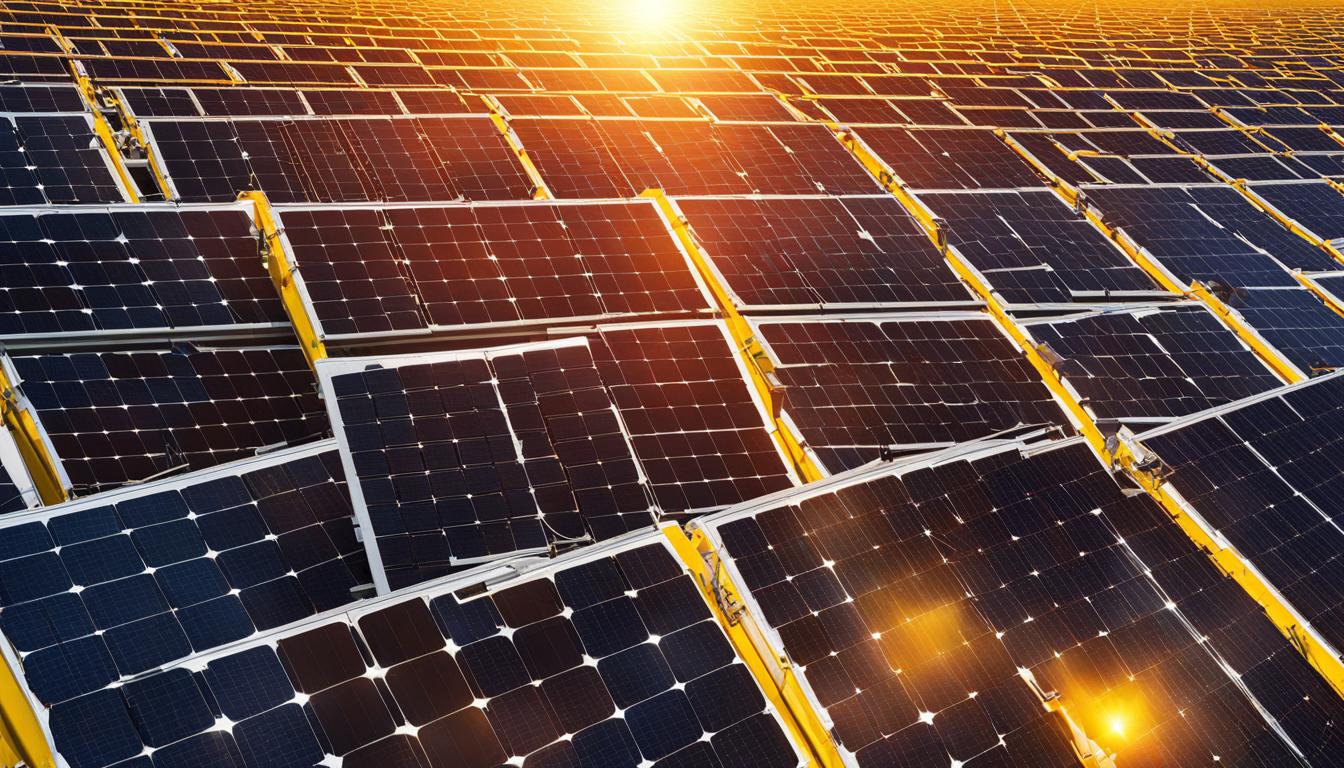


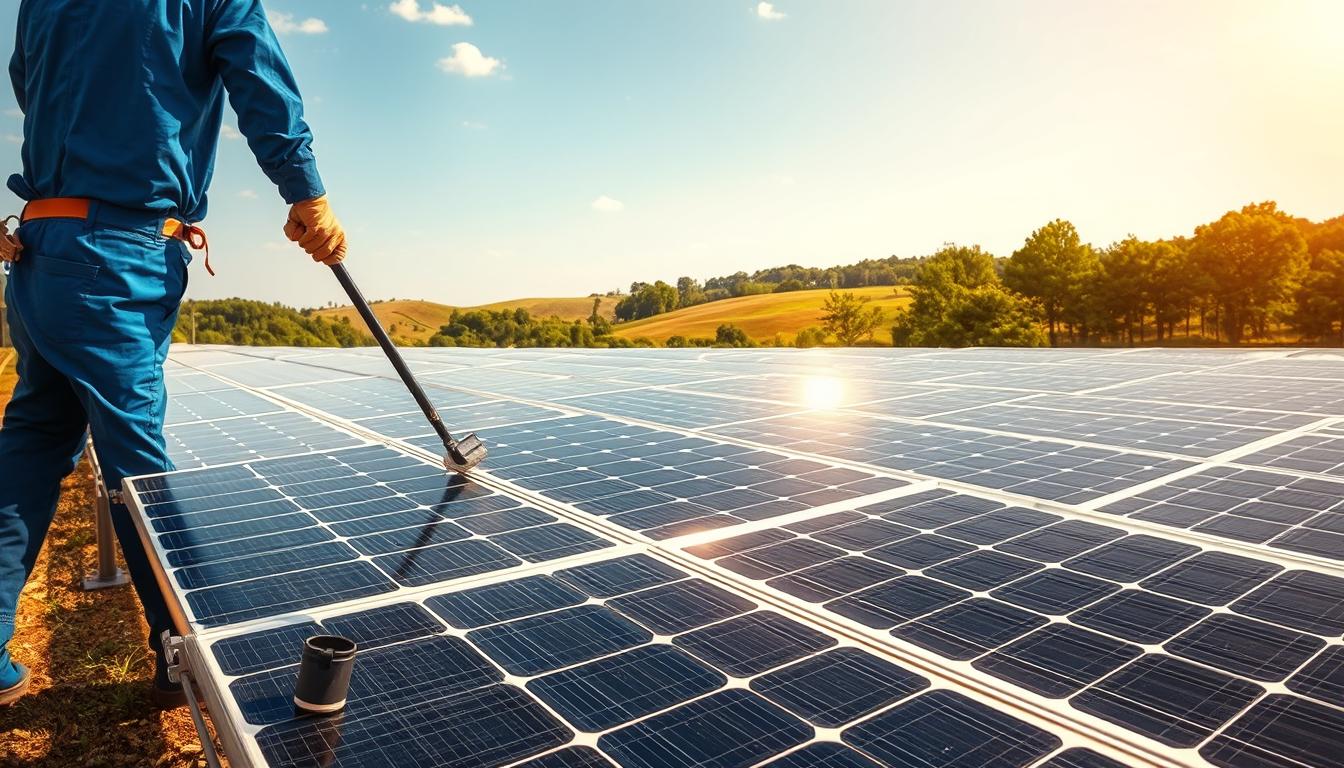
AC or DC, who needs a superhero when you have solar panels? #PowerPlay
AC or DC, who cares? Just give me all the solar-powered gadgets! 🌞🔌
In my opinion, who needs AC when we can all go DC and embrace the solar power revolution? 🌞💡
AC or DC? Who cares! Just give me free electricity from the sun! 🌞🔌💡 #SolarPowerForTheWin
AC or DC, lets settle this once and for all – solar panels should produce AC AND DC! #HybridPower
I think we should all switch to using solar panel-generated DC electricity!
I think we should consider using solar panels to power our cars!
AC is overrated! DC all the way for solar panels output. Lets debate!
I think using AC for solar panels is outdated, DC is the future!
AC is overrated! DC all the way for solar panel output efficiency.
AC is overrated! DC from solar panels is the future. Change my mind.
I think we should power our homes with solar panels to save money.
AC or DC, which is more efficient for solar panels? Lets debate!
DC output from solar panels is more efficient for off-grid systems. Less energy loss!
AC is outdated, DC is the future for solar panels. Whos with me? 🌞
AC may be outdated, but it still has its place in the solar panel industry. DC may be the future, but lets not overlook the benefits that AC systems bring. Both have their advantages and its important to consider all options before jumping to conclusions. 🌞
AC is overrated! DC from solar panels is the future. Embrace the change!
AC is so last season! DC all the way for maximum solar efficiency. #TeamDC
AC is outdated, DC is the future of solar panel output! 🌞🔌
AC is overrated! DC is the future of solar panel output. Trust me.
AC power is overrated! DC output is the future of solar panels. #ControversialOpinion
AC power may be traditional, but DC output is far from being the future of solar panels. The efficiency and convenience of AC power cannot be dismissed so easily. #ACPowerFTW #NotBuyingIt
AC is overrated, DC is the future of solar energy efficiency. #TeamDC 💡
AC may have its advantages, but lets not underestimate the potential of DC in the realm of solar energy. Innovation is key, and #TeamDC is definitely onto something revolutionary. Lets keep an open mind and embrace the future of energy efficiency. 💡
AC is overrated, DC is the future! Embrace the power of solar panels!
AC may be overrated to some, but its still the dominant electrical current for a reason. DC may have its benefits, but lets not count out AC just yet. And lets not forget that solar panels can work with both AC and DC systems. Why limit ourselves?
AC is overrated! DC is the future of solar panel output. Lets discuss!
Interesting points on solar panel technology. But dont you think the article couldve explored more on the efficiency of DC over AC in terms of energy loss during transmission?
Interesting read! But, isnt the conversion efficiency from DC to AC also a major factor? Its not just about solar panels producing DC, its also about how much we lose during conversion.
I get the DC part, but why not use AC right off the bat? Wouldnt it cut down on the need for inverters and simplify the whole system? Just a thought.
Interesting read, but arent we overlooking the efficiency loss during the DC to AC conversion process? I reckon we should explore more on direct DC applications. Anyone else thinking the same?
Interesting read, but arent we overlooking micro-inverters role in converting DC to AC right at the solar panel? Worth a deeper dive, IMO. Theyre a game-changer in solar tech efficiency.
Interesting read, but I think theres a bigger question were missing. If we can harness the suns energy, why the heck are we still paying for electricity? Yes, I get the whole infrastructure and maintenance thing, but shouldnt this be a public service by now? Just food for thought. #SolarPowerForAll.
Infrastructure and maintenance arent cheap, mate. Free lunch doesnt exist, even with solar power. #RealityCheck
Just read this piece about solar panels producing DC power. It got me thinking, why dont we just redesign our appliances to run on DC instead of converting it to AC? Wouldnt that make more sense and save us energy? I mean, it’s not rocket science, right? Or am I missing something here?
Enjoyed reading the article guys, but dont you think its high time we moved away from AC and completely embraced DC? I mean, solar panels are already producing DC. Why not streamline the whole process? Reducing the need for inverters could lower costs and increase efficiency. Just a thought.
I still cant decide if AC or DC is better for solar panels. AC may be more efficient for long-distance transmission, but DC seems more straightforward. What do you think?
I think the debate between using AC or DC in solar panels is fascinating! I wonder which one is more efficient in terms of energy conversion. Its like the ultimate showdown between old school and new school technology!
Interesting insights on solar panels output. But, wouldnt it be more practical for all devices to adapt to DC, given that its solar panels primary output? Just food for thought.
Interesting read, but shouldnt we also consider the efficiency loss during the DC to AC conversion? I mean, doesnt this process inevitably lead to power wastage?
Interesting read, but wouldnt it make more sense if solar panels produced AC directly? Itd save us the hassle and inefficiency of inverters, wouldnt it? Just a thought, guys. Keep things sunny-side up!
Interesting read, but dont you think its time we move beyond AC/DC debate and focus on efficiency? Like, are we getting the most out of sunlight with current photovoltaic technology? Just food for thought.
Interesting read! But wouldnt the efficiency of solar panels improve if we could directly use DC instead of converting it to AC? Just a wild thought! Lets challenge the norm, folks!
Interesting article! But isnt it better to use DC for homes directly to reduce energy losses during the conversion process?
Indeed, direct DC might reduce losses, but ever considered the safety and equipment compatibility issues?
Interesting read, but isnt it more efficient to use DC directly for home appliances instead of converting it to AC?
I reckon the article didnt delve deep into the AC/DC conversion losses. Whats the average efficiency gap guys?
While the article explains DC produced by solar panels, it doesnt clarify why inverters are necessary. Cant we use DC directly?
Interesting read! But, isnt AC more efficient for long-distance transmission? Could this impact solar farms locations?